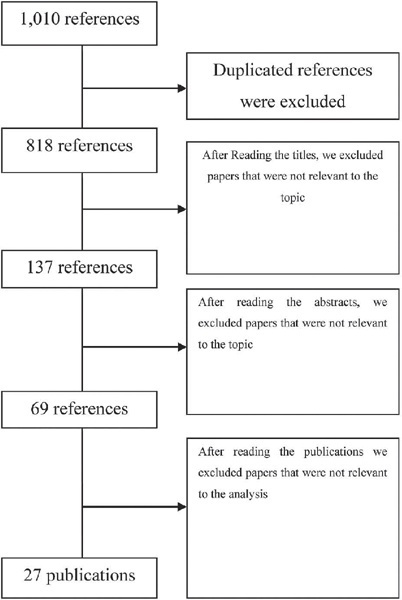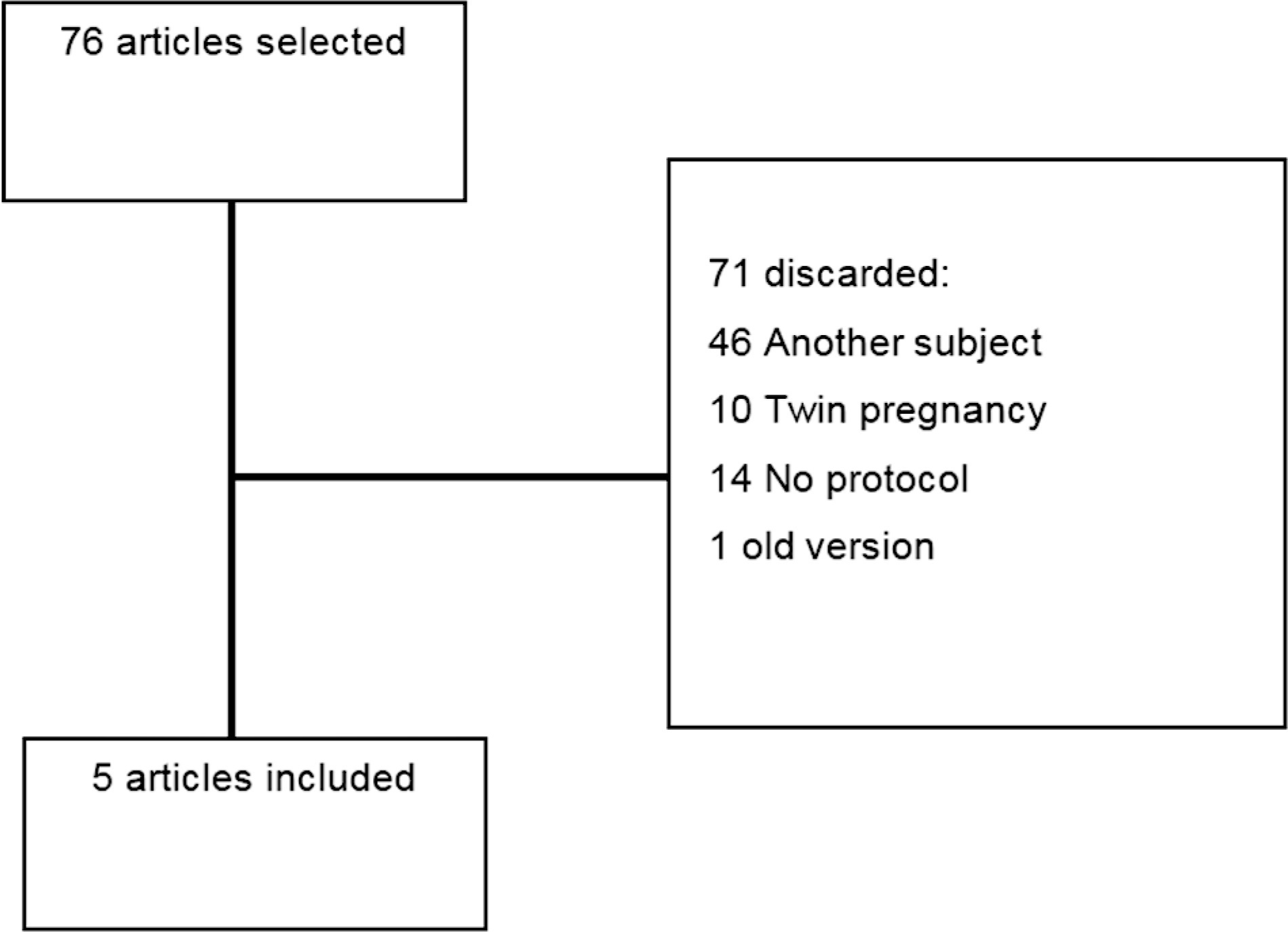-
Review Article08-04-2023
COVID-19 and Preeclampsia: A Systematic Review of Pathophysiological Interactions
Revista Brasileira de Ginecologia e Obstetrícia. 2023;45(6):347-355
Abstract
Review ArticleCOVID-19 and Preeclampsia: A Systematic Review of Pathophysiological Interactions
Revista Brasileira de Ginecologia e Obstetrícia. 2023;45(6):347-355
Views278See moreAbstract
Objective:
To review the literature and synthesize evidence on pathophysiological interactions attributed to the simultaneous occurrence of COVID-19 and preeclampsia.
Methods:
A systematic review was conducted from November (2021) to January (2022) to retrieve observational studies published on the PubMed, LILACS, SciELO Brazil and Google Scholar databases. The search was based on the descriptors [(eclampsia OR preeclampsia) AND (COVID-19)]. Quantitative studies that pointed to pathophysiological interactions were included. Literature reviews, studies with HIV participants, or with clinical approach only were excluded. The selection of studies was standardized and the evaluation was performed by pairs of researchers.
Results:
In this review, 155 publications were retrieved; 16 met the inclusion criteria. In summary, the physiological expression of angiotensin-converting enzyme-2 (ACE-2) receptors is physiologically increased in pregnant women, especially at the placental site. Studies suggest that the coronavirus binds to ACE-2 to enter the human cell, causing deregulation of the renin-angiotensin-aldosterone system and in the ratio between angiotensin-II and angiotensin-1-7, inducing manifestations suggestive of preeclampsia. Furthermore, the cytokine storm leads to endothelial dysfunction, vasculopathy and thrombus formation, also present in preeclampsia.
Conclusion:
The studies retrieved in this review suggest that there is a possible overlap of pathophysiological interactions between COVID-19 and preeclampsia, which mainly involve ACE-2 and endothelial dysfunction. Given that preeclampsia courses with progressive clinical and laboratory alterations, a highly quality prenatal care may be able to detect specific clinical and laboratory parameters to differentiate a true preeclampsia superimposed by covid-19, as well as cases with hypertensive manifestations resulting from viral infection.
-
Review Article07-10-2023
Technologies Applied to the Mental Health Care of Pregnant Women: A Systematic Literature Review
Revista Brasileira de Ginecologia e Obstetrícia. 2023;45(3):149-159
Abstract
Review ArticleTechnologies Applied to the Mental Health Care of Pregnant Women: A Systematic Literature Review
Revista Brasileira de Ginecologia e Obstetrícia. 2023;45(3):149-159
Views266See moreAbstract
Objective:
This article aims to review the literature regarding the use of technologies to promote mental health for pregnant women. We seek to: understand the strategies that pregnant women use for mental health care. Also, we investigate the existence of scientific evidence that validates such practices.
Methods:
This study follows the PRISMA guidelines for systematic reviews. We analyze 27 studies published between 2012 and 2019. We include publications in Portuguese, English, and Spanish.
Results:
The results revealed several different possibilities to use technology, including the use of text messages and mobile applications on smartphones. Mobile applications are the most commonly used approaches (22.5%). Regarding the strategies used, cognitive-behavioral approaches, including mood checks, relaxation exercises, and psychoeducation comprised 44.12% of the content.
Conclusion:
There is a need for further investigation and research and development efforts in this field to better understand the possibilities of intervention in mental health in the digital age.

-
Review Article07-10-2023
Comparison between Protocols for Management of Fetal Growth Restriction
Revista Brasileira de Ginecologia e Obstetrícia. 2023;45(2):096-103
Abstract
Review ArticleComparison between Protocols for Management of Fetal Growth Restriction
Revista Brasileira de Ginecologia e Obstetrícia. 2023;45(2):096-103
Views253See moreAbstract
This comprehensive review compares clinical protocols of important entities regarding the management of fetal growth restriction (FGR), published since 2015. Five protocols were chosen for data extraction. There were no relevant differences regarding the diagnosis and classification of FGR between the protocols. In general, all protocols suggest that the assessment of fetal vitality must be performed in a multimodally, associating biophysical parameters (such as cardiotocography and fetal biophysical profile) with the Doppler velocimetry parameters of the umbilical artery, middle cerebral artery, and ductus venosus. All protocols reinforce that the more severe the fetal condition, the more frequent this assessment should be made. The timely gestational age and mode of delivery to terminate the pregnancy in these cases can vary much between the protocols. Therefore, this paper presents, in a didactic way, the particularities of different protocols for monitoring FGR, in order to help obstetricians to better manage the cases.

-
Review Article06-30-2023
Impact of Maternal Folic Acid Supplementation on Descendants’ Kidney in Adulthood
Revista Brasileira de Ginecologia e Obstetrícia. 2023;45(4):207-214
Abstract
Review ArticleImpact of Maternal Folic Acid Supplementation on Descendants’ Kidney in Adulthood
Revista Brasileira de Ginecologia e Obstetrícia. 2023;45(4):207-214
Views143See moreAbstract
Supplementation with folic acid (FA) during gestation has been recommended by medical society all over the world, but some studies have shown that intake of high folic acid diet may unleash damages to the descendants. Objectives: Describing the effects of maternal supplementation with FA during gestation on offspring's kidney at late life stages. Data Source: It is a systematic review by which were consulted the following databases: Medline, through Pubmed, Lilacs, and SciELO. The research was performed using the keywords “Folic acid”, “Gestation” and “Kidney”. Study Selection: Eight studies were regarded for this systematic review. Data Collection: Only studies that evaluated folic acid consumption during gestation and its effects exclusively on descendants' kidney at several phases of life were regarded. Results: Gestational FA intake did not change the renal volume, glomerular filtration rate and the expression of some essential genes in the kidney of puppies whose dams were supplemented with FA. Maternal consumption of double FA plus selenium diet was effective in preserving antioxidant enzymes activity in the kidney of descendants from mothers exposed to alcohol. FA supplementation decreased some gross anomalies in the puppies caused by teratogenic drug despite of had not been effective in preventing some renal architectural damages. Conclusion: FA supplementation did not cause renal toxicity; it exerted an antioxidant protective effect and mitigated some renal disorders caused by severe aggressions.
-
Review Article04-14-2023
Corifollitropin Alfa for Controlled Ovarian Stimulation in Assisted Reproductive Technologies: State of the Art
Revista Brasileira de Ginecologia e Obstetrícia. 2023;45(1):43-48
Abstract
Review ArticleCorifollitropin Alfa for Controlled Ovarian Stimulation in Assisted Reproductive Technologies: State of the Art
Revista Brasileira de Ginecologia e Obstetrícia. 2023;45(1):43-48
Views104Abstract
Physical and emotional burdens during the journey of infertile people through assisted reproductive technologies are sufficient to justify the efforts in developing patient-friendly treatment strategies. Thus, shorter duration of ovarian stimulation protocols and the need for less injections may improve adherence, prevent mistakes, and reduce financial costs. Therefore, the sustained follicle-stimulating action of corifollitropin alfa may be the most differentiating pharmacokinetic characteristic among available gonadotropins. In this paper, we gather the evidence on its use, aiming to provide the information needed for considering it as a first choice when a patient-friendly strategy is desired.
Key-words Assisted fertilizationcorifollitropin alfaGnRH antagonistOvarian stimulationOvulation InductionSee more -
Review Article03-24-2022
Assessment of Pelvic Floor Disorders due to the Gestational Diabetes Mellitus Using Three-Dimensional Ultrasonography: A Narrative Review
Revista Brasileira de Ginecologia e Obstetrícia. 2022;44(12):1134-1140
Abstract
Review ArticleAssessment of Pelvic Floor Disorders due to the Gestational Diabetes Mellitus Using Three-Dimensional Ultrasonography: A Narrative Review
Revista Brasileira de Ginecologia e Obstetrícia. 2022;44(12):1134-1140
Views184See moreAbstract
Gestational diabetes mellitus (GDM)is an entity with evolving conceptual nuances that deserve full consideration. Gestational diabetes leads to complications and adverse effects on the mother's and infants' health during and after pregnancy. Women also have a higher prevalence of urinary incontinence (UI) related to the hyperglycemic status during pregnancy. However, the exact pathophysiological mechanism is still uncertain. We conducted a narrative review discussing the impact of GDM on the women's pelvic floor and performed image assessment using three-dimensional ultrasonography to evaluate and predict future UI.
-
Review Article03-24-2022
Commercial Surrogacy: An Overview
Revista Brasileira de Ginecologia e Obstetrícia. 2022;44(12):1141-1158
Abstract
Review ArticleCommercial Surrogacy: An Overview
Revista Brasileira de Ginecologia e Obstetrícia. 2022;44(12):1141-1158
Views422See moreAbstract
Objective
Surrogacy is the process in which a woman carries and delivers a baby to other person or couple, known as intended parents. When carriers are paid for surrogacy, this is known as commercial surrogacy. The objective of the present work is to review the legal, ethical, social, and cultural aspects of commercial surrogacy, as well as the current panorama worldwide.
Methods
This is a review of the literature published in the 21st century on commercial surrogacy.
Results
A total of 248 articles were included as the core of the present review. The demand for surrogate treatments by women without uterus or with important uterine disorders, single men and same-sex male couples is constantly increasing worldwide. This reproductive treatment has important ethical dilemmas. In addition, legislation defers widely worldwide and is in constant change. Therefore, patients look more and more for treatments abroad, which can lead to important legal problems between countries with different laws. Commercial surrogacy is practiced in several countries, in most of which there is no specific legislation. Some countries have taken restrictive measures against this technique because of reports of exploitation of carriers.
Conclusion
Commercial surrogacy is a common practice, despite important ethical and legal dilemmas. As a consequence of diverse national legislations, patients frequently resort to international commercial surrogacy programs. As of today, there is no standard international legal context, and this practice remains largely unregulated.
-
Review Article03-24-2022
Maternal Mercury Exposure and Hypertensive Disorders of Pregnancy: A Systematic Review
Revista Brasileira de Ginecologia e Obstetrícia. 2022;44(12):1126-1133
Abstract
Review ArticleMaternal Mercury Exposure and Hypertensive Disorders of Pregnancy: A Systematic Review
Revista Brasileira de Ginecologia e Obstetrícia. 2022;44(12):1126-1133
Views171See moreAbstract
Objective
The present review aimed to synthesize the evidence regarding mercury (Hg) exposure and hypertensive disorders of pregnancy (HDP).
Data Sources
The PubMed, BVS/LILACS, SciELO and UFRJ's Pantheon Digital Library databases were systematically searched through June 2021.
Study Selection
Observational analytical articles, written in English, Spanish, or Portuguese, without time restriction.
Data Collection
We followed the PICOS strategy, and the methodological quality was assessed using the Downs and Black checklist.
Data Synthesis
We retrieved 77 articles, of which 6 met the review criteria. They comprised 4,848 participants, of which 809 (16.7%) had HDP and 4,724 (97.4%) were environmentally exposed to Hg (fish consumption and dental amalgam). Mercury biomarkers evaluated were blood (four studies) and urine (two studies). Two studies found a positive association between Hg and HDP in the group with more exposure, and the other four did not present it. The quality assessment revealed three satisfactory and three good-rated studies (mean: 19.3 ± 1.6 out 28 points). The absence or no proper adjustment for negative confounding factor, such as fish consumption, was observed in five studies.
Conclusion
We retrieved only six studies, although Hg is a widespread toxic metal and pregnancy is a period of heightened susceptibility to environmental threats and cardiovascular risk. Overall, our review showed mixed results, with two studies reporting a positive association in the group with more exposure. However, due to the importance of the subject, additional studies are needed to elucidate the effects of Hg on HDP, with particular attention to adjusting negative confounding.


